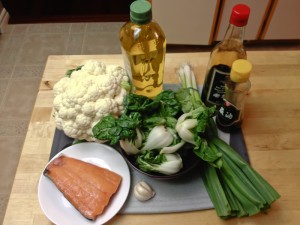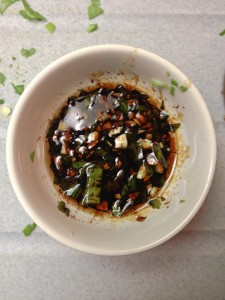I know what you’re thinking—cauliflower rice is not a thing.
Truth is, I’ve never been a fan of broccoli’s albino cousin. But I’m a believer in trying all foods at least once, so I thought I’d give this a whirl. Turns out, it’s super easy to make (which I am always a fan of). It doesn’t really taste like rice, but if you’re looking for a paleo or gluten-free alternative, this is it.
I was raised an omnivore, but the amount of time and preparation that goes into cooking meat drives me nuts. I’ve been on a fish kick for this reason—fish fillets or steaks take way less time to cook and prepare.
This recipe uses Atlantic salmon (because it was on sale last week at the grocery store), but I’ve also tried it on rainbow trout (which is usually cheaper) and it tastes just as delicious. Fish isn’t that cheap, but this recipe is a good one if you feel like treating yourself once in a while.
Now here’s the thing about bok choy—you can’t just run it under the tap like every other vegetable. Because of the way bok choy sprouts, dirt gets trapped inside easily. The best way to wash it is to fill your sink with cold water and the choy to try to get some of the initial dirt out, and then rinse it again.
The recipe also says that we’re making baby bok choy, which is sometimes a misnomer. When you go to a restaurant, you’ll probably be ordering “baby bok choy” off the menu, but that same vegetable at the supermarket is sometimes labelled “bok choy sprouts.” They taste the same, but I like the sprouts better because they’re smaller pieces of the same thing.
1 4 oz. salmon or trout fillet
1/4 head of cauliflower
bok choy (whatever quantity you feel like eating)
5 cloves garlic
1/2 green onion, finely chopped
4 tablespoons canola or vegetable oil
2 tablespoons dark soy sauce
1 1/2 teaspoons sesame oil
There are two ways you can get cauliflower down to the size of rice. You can either use a food processor or Magic Bullet-type appliance (recommended), or you can chop up the cauliflower with a knife for a long time. I lacked a food processor and didn’t want to wake up my sick roommate, so I chopped it up myself. Luckily, cauliflower is like broccoli and breaks apart fairly easily.
Since you’re treating the cauliflower like rice, you can either eat it plain or with a sauce. I tried it with light soy sauce and it tasted great, but if you want something lighter, a bit of extra-virgin oil and lemon juice would be good too.
1.) Place cauliflower florets in a food processor and pulse until it’s chopped into small, rice-sized pieces.
2.) Place cauliflower in a microwave-safe bowl and cover with plastic wrap.
3.) Microwave on high for seven minutes. Don’t add oil or any other liquids before microwaving—the cauliflower has plenty of moisture in it that will help it cook.
4.) Remove plastic wrap, fluff with a fork.
I don’t have a barbecue, so I use a grill pan (it’s basically a non-stick frying pan with grill marks) on the stove. You could also use a non-stick frying pan. You don’t need a lot of oil—if the fish is sticking to the pan, don’t flip it yet.
1.) Mince one clove garlic and green onion.
2.) Mix dark soy sauce and sesame oil in a small bowl. Add garlic and green onion and set aside.
3.) Heat one tablespoon of canola or vegetable oil in a frying pan or grill pan on medium heat.
4.) Pour sauce mixture over the salmon. Once the pan is hot enough, put the salmon in it.
5.) Cook the salmon for about three minutes on each side. Cooking time will vary depending on the size of the fillet.
Bok choy:
When you order baby bok choy at a restaurant, it’s usually made with a garlic sauce. I use garlic and canola oil, because those are ingredients I always have on hand. Garlic is cheap and makes vegetables taste better, so if I want the vegetables to taste more garlicky, I just add more. It’s that simple.
1.) Wash your vegetables. Soak in cold water for a few minutes and knock off some of the excess dirt. Rinse in a colander afterwards and dry if you’ve got a salad spinner.
2.) Chop four cloves garlic. Heat three tablespoons canola or vegetable oil and garlic in a pan on medium-high heat.
3.) Add bok choy. Cover for about four minutes, and then cook uncovered for about seven minutes or until bok choy is at your preferred crunchiness level. I like mine more crunchy, so I cook it for less than seven minutes.
4.) Salt to taste.
–@thisisjesschin







![Here’s how your favorite media platforms shape your world view without you realizing it Advertising revenue and subscriptions are the main source of income for news outlets. [Graphic by Sara Mizannojehdehi]](https://charlatan.ca/wp-content/uploads/2021/07/11BE7ADB-1CC8-46E8-ADB4-568B3C7F1265-265x198.jpeg)